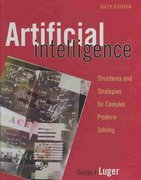The area of agent-based research was introduced in Section 12.3. We recommend further reading on any of
Question:
The area of agent-based research was introduced in Section 12.3. We recommend further reading on any of the projects mentioned, but especially the Brooks, Nilsson and Benson, or Crutchfield and Mitchell research. Write a short paper on one of these topics.
Data from section 12.3
Earlier in this chapter, we described a simplified version of “The Game of Life.” This game, most effectively shown in computational visual simulations where succeeding generations rapidly change and evolve on a screen display, has a very simple specification.
It was first proposed as a board game by the mathematician John Horton Conway, and made famous through Martin Gardner’s discussion of it in Scientific American (1970, 1971). The Game of Life is a simple example of a model of computation called cellular automata (CA). Cellular automata are families of simple, finite-state machines that exhibit interesting, emergent behaviors through their interactions in a population. D E F I N I T I O N FINITE-STATE MACHINE or CELLULAR AUTOMATON 1. A set I called the input alphabet.
2. A set S of states that the automaton can be in.
3. A designated state s0, the initial state.
4. A next state function N: S x I → S, that assigns a next state to each ordered pair consisting of a current state and a current input.
The output of a Finite State Machine, as presented previously in Section 3.1, is a function of its present state and input values. The cellular automata make the input to the present state a function of its “neighbor” states. Thus, the state at time (t + 1) is a function of its present state and the state of its neighbors at time t. $3It is through these interactions with neighbors that collections of cellular automata achieve much richer behaviors than simple finite state machines. Because the output of all states of a system is a function of their neighboring states, we can describe the evolution of a set of neighboring FSMs as society-based adaptation and learning.
For the societies described in this section, there is no explicit evaluation of the fitness of individual members. Fitness results from interactions in the population, interactions that may lead to the “death” of individual automata. Fitness is implicit in the survival of individuals from generation to generation. Learning among cellular automata is typically unsupervised; as occurs in natural evolution, adaptation is shaped by the actions of other, co-evolving members of the population. A global, or society-oriented viewpoint also allows an important perspective on learning.
We no longer need to focus exclusively on the individual, but can rather see invariances and regularities emerging within the society as a whole. This is an important aspect of the Crutchfield−Mitchell research presented in Section 12.3.2.
Finally, unlike supervised learning, evolution need not be “intentional”. That is, the society of agents need not be seen as “going somewhere”, say to some “omega” point. We did have a convergence bias when we used the explicit fitness measures in the earlier sections of this chapter. But as Stephen Jay Gould (1977, 1996) points out, evolution need not be viewed as making things “better”, rather it just favors survival. The only success is continued existence, and the patterns that emerge are the patterns of a society.
Step by Step Answer:

Artificial Intelligence Structures And Strategies For Complex Problem Solving
ISBN: 9780321545893
6th Edition
Authors: George Luger





